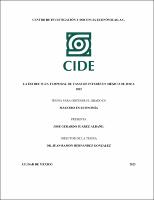| dc.contributor.advisor | Dr. Juan Ramón Hernández González |
| dc.creator | Juárez Albañil, José Gerardo |
| dc.date.issued | 2023 |
| dc.identifier | 176525.pdf |
| dc.identifier.uri | http://hdl.handle.net/11651/5596 |
| dc.description.abstract | En este trabajo se estiman los Componentes Principales de la Estructura Temporal de Tasas de Interés en México y se analiza su relación con la postura de política monetaria y el ciclo económico. Se muestra que la correlación entre el primer componente con la tasa de fondeo es similar a la encontrada por otros estudios; sin embargo, la asociación entre el segundo componente y la brecha del producto disminuyó. Posteriormente se estiman cuatro modelos VAR y sus funciones impulso respuesta ortogonalizadas, los primeros dos con el primer componente y nueve variables macroeconómicas y financieras donde el primero se estima con observaciones de 2010 a 2019, y el segundo con la muestra 2010 a 2022, la cual incorpora las perturbaciones que generó la contingencia sanitaria; para los modelos tres y cuatro se procede de manera análoga con el segundo componente. Se muestra que choques en el precio del petróleo, el índice VIX, la liquidez estadounidense, el diferencial de tasas, la inflación y el tipo de cambio influyen en la Estructura Temporal de Tasas de Interés en México y que la magnitud de la respuesta cambió con la pandemia. |
| dc.description.abstract | This dissertation estimates the Principal Components of the Term Structure of Interest Rates in Mexico and analyzes their relationship with the monetary policy stance and the business cycle. It is shown that the correlation between the first component and the funding rate is similar to that found in other studies; however, the association between the second component and the output gap decreased. Subsequently, four VAR models and their orthogonalized impulse response functions are estimated, the first two with the first component and nine macroeconomic and financial variables where the first one is estimated with observations from 2010 to 2019, and the second one with the sample 2010 to 2022, which incorporates the shocks generated by the health contingency; for models three and four we proceed analogously with the second component. We show that shocks to oil prices, the VIX index, U.S. liquidity, the interest rate spread, inflation and the exchange rate influence the Term Structure of Interest Rates in Mexico and that the magnitude of the response changed with the pandemic. |
| dc.format | application/PDF |
| dc.language.iso | spa |
| dc.publisher | El Autor |
| dc.rights | Con fundamento en los artículos 21 y 27 de la Ley Federal del Derecho de Autor y como titular de los derechos moral y patrimonial, otorgo de manera gratuita y permanente al Centro de Investigación y Docencia Económicas, A.C. y a su Biblioteca autorización para que fije la obra en cualquier medio, incluido el electrónico, y la divulguen entre sus usuarios, profesores, estudiantes o terceras personas, sin que pueda percibir por tal divulgación una contraprestación. |
| dc.subject.lcsh | Interest rates -- Effect of monetary policy on -- Mexico -- Econometric models -- 2010-2022. |
| dc.subject.lcsh | COVID-19 Pandemic, 2020- -- Mexico -- Econometric models. |
| dc.title | La estructura temporal de tasas de interés en México de 2010 a 2022 |
| dc.title.alternative | The term structure of interest rates in Mexico from 2010 to 2022 |
| dc.type | Tesis de maestría |
| dc.accessrights | Acceso abierto |
| dc.recordIdentifier | 000176525 |
| dc.rights.license | Creative Commons Reconocimiento-NoComercial-SinObraDerivada 4.0 Internacional CC BY-NC-ND |
| thesis.degree.grantor | Centro de Investigación y Docencia Económicas |
| thesis.degree.name | Maestría en Economía |
| dc.proquest.rights | Yes |


